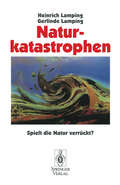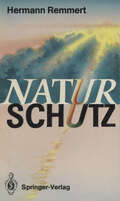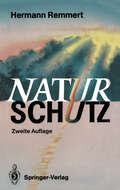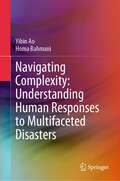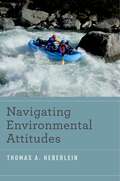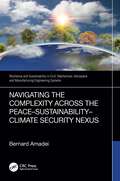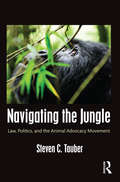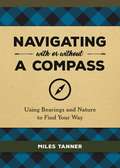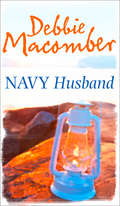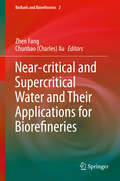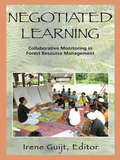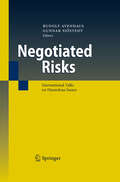- Table View
- List View
Nature's Temples: A Natural History of Old-Growth Forests Revised and Expanded
by Joan MaloofAn impassioned case for the importance of ancient forests and their preservationStanding in an old-growth forest, you can instinctively sense the ways it is different from forests shaped by humans. These ancient, undisturbed ecosystems are increasingly rare and largely misunderstood. Nature’s Temples explores the science and alchemy of old-growth forests and makes a compelling case for their protection.Many foresters are proponents of forest management, while ecologists and conservation biologists believe that the healthiest forests are those we leave alone. Joan Maloof brings together the scientific data we have about old-growth forests, drawing on diverse fields of study to explain the ecological differences among forests of various ages. She describes the life forms and relationships that make old-growth forests unique—from salamanders and micro-snails to plants that communicate through fungi—and reveals why human attempts to manage forests can never replicate nature’s sublime handiwork. This revised and expanded edition also sheds new light on the special role forests play in removing carbon from the atmosphere and shares what we know about the interplay between wildfires and ancient forests.With drawings by Andrew Joslin that illustrate scientific concepts and capture the remarkable beauty of ancient trees, Nature’s Temples invites you to discover the power of these fragile realms that are so inextricably connected to our planet, our fellow species, and our spirits.
Nature’s Wonders: Moments that mark the seasons (National Trust)
by Jane V. Adams National Trust BooksBritain’s nature year, from the first flower to the last leaf
Naturkatastrophen: Spielt die Natur verrückt?
by Heinrich Lamping Gerlinde LampingNaturkatastrophen vernichten jedes Jahr Tausende von Menschenleben - spielt die Natur verrückt? Die Autoren zeigen, wie aus den Launen der Natur Katastrophen werden und welchen Anteil der Mensch daran hat.
Naturschutz: Ein kritischer Ansatz
by Klaus-Dieter HupkeIn Naturschutzgebieten geschieht vieles, das auf den ersten Blick widersprüchlich ist. So werden beim Pflegeeinsatz Blumenwiesen abgemäht, wo doch alle dort wachsenden Pflanzen unter Naturschutz stehen. An anderer Stelle werden im Flachmoor geschützte Schilfbestände abgebrannt oder in einem Dünenschutzgebiet die oberste Bodenschicht mit Planierraupen abgetragen. Wiederum andere Flächen sollen völlig unberührt von menschlichen Eingriffen bleiben. Der Autor Klaus-Dieter Hupke zeigt die verschiedenen Strategien von Naturschutz auf. Er zeigt auch, dass Naturschutz zumeist gerade das nicht ist, was der Begriff im Kern aussagt: „Schutz der Natur“. In Mitteleuropa handelt es sich bei Naturschutzgebieten im Gegenteil überwiegend um die Relikte alter Agrar- und damit Kulturlandschaften. Oftmals stehen auch ästhetische Aspekte eines Landschaftsausschnitts bei der Ausweisung als Naturdenkmal oder Naturschutzgebiet im Vordergrund. Darüber hinaus läuft der Naturschutz Gefahr, zur Ersatzhandlung und zum Alibi für eine in Mitteleuropa wie global immer noch wachsende Zerstörung traditioneller und naturnaher Landschaftssysteme zu werden.
Naturschutz: Eine kritische Einführung
by Klaus-Dieter HupkeIn Naturschutzgebieten geschieht vieles, das auf den ersten Blick widersprüchlich ist. So werden beim Pflegeeinsatz Blumenwiesen abgemäht, wo doch alle dort wachsenden Pflanzen unter Naturschutz stehen. An anderer Stelle werden im Flachmoor geschützte Schilfbestände abgebrannt oder in einem Dünenschutzgebiet die oberste Bodenschicht mit Planierraupen abgetragen. Wiederum andere Flächen sollen völlig unberührt von menschlichen Eingriffen bleiben. Der Autor Klaus-Dieter Hupke zeigt die verschiedenen Strategien von Naturschutz auf. Er zeigt auch, dass Naturschutz zumeist gerade das nicht ist, was der Begriff im Kern aussagt: „Schutz der Natur“. In Mitteleuropa handelt es sich bei Naturschutzgebieten im Gegenteil überwiegend um die Relikte alter Agrar- und damit Kulturlandschaften. Oftmals stehen auch ästhetische Aspekte eines Landschaftsausschnitts bei der Ausweisung als Naturdenkmal oder Naturschutzgebiet im Vordergrund. Darüber hinaus läuft der Naturschutz Gefahr, zur Ersatzhandlung und zum Alibi für eine in Mitteleuropa wie global immer noch wachsende Zerstörung traditioneller und naturnaher Landschaftssysteme zu werden.Die aktualisierte zweite Auflage bezieht die Folgen des Klimawandels für den Naturschutz nun explizit ein und hat auch an einigen Stellen für die entsprechenden Leser einen stärkeren Bezug auf Österreich sowie auf den zentralalpinen Raum eingearbeitet.
Naturschutz: Ein Lesebuch nicht nur für Planer, Politiker und Polizisten, Publizisten und Juristen
by Hermann RemmertProfessor Hermann Remmert, führender Ökologie-Experte und Autor zahlreicher wissenschaftlicher Publikationen, gibt hier eine gut lesbare und auch für den Laien verständliche Einführung in die viel-diskutierte Thematik: Naturschutz. Ausgehend von uns überlieferten ökologischen Katastrophen aus früherer Zeit (der älteste Bericht über die Verkarstung des Gebirges durch menschlichen Einfluß stammt von Plato, circa 400 v.Chr.) und deren Bewältigung führt der Autor in alle Aspekte des modernen Naturschutzes ein. Die Gliederung des Buches folgt den Fragestellungen: - Was ist Naturschutz? - Warum brauchen wir ihn, für wen und für was? - Wer hat zu schützen, und was? - Wie hat das zu geschehen (Artenschutz, Biotopschutz, Schutz der ökologischen Prozesse)? - Wo muß der Naturschutz einsetzen? - Wie groß müssen Naturschutzgebiete sein? - Was "kosten" Naturschutzgebiete? - Wie werden die Konzepte des Naturschutzes in der Lehre behandelt, weitergegeben und letzlich realisiert? Diese Thematik wird ergänzt durch die Erörterung des rechtlichen Rahmens, innerhalb dessen Naturschutz verankert werden kann und sollte. In einer lebendigen Sprache und anhand von plastischen Beispielen stellt H. Remmert die heutige Situation des Naturschutzes speziell für diejenigen dar, die zunächst dem Naturschutz beruflich und gedanklich fernstehen, aber im Zuge unserer Umweltkrise nun direkt - und sei es nur im Urlaub - mit (mangelndem) Naturschutz konfrontiert werden.
Naturschutz: Ein Lesebuch nicht nur für Planer, Politiker, Polizisten, Publizisten und Juristen
by Hermann RemmertProfessor Hermann Remmert, führender Ökologie-Experte und Autor zahlreicher wissenschaftlicher Publikationen, gibt hier eine gut lesbare und auch für den Laien verständliche Einführung in die viel-diskutierte Thematik: Naturschutz. Die Gliederung des Buches folgt den Fragestellungen: - Was ist Naturschutz? - Warum brauchen wir ihn, für wen und für was? - Wer hat zu schützen, und was? - Wie hat das zu geschehen (Artenschutz, Biotopschutz, Schutz der ökologischen Prozesse)? - Wo muß der Naturschutz einsetzen? - Wie groß müssen Naturschutzgebiete sein? - Was "kosten" Naturschutzgebiete? - Wie werden die Konzepte des Naturschutzes in der Lehre behandelt, weitergegeben und letztlich realisiert? Diese Thematik wird ergänzt durch die Erörterung des rechtlichen Rahmens, innerhalb dessen Naturschutz verankert werden kann und sollte. In einer lebendigen Sprache und anhand von plastischen Beispielen stellt H. Remmert die heutige Situation des Naturschutzes speziell für diejenigen dar, die zunächst dem Naturschutz beruflich und gedanklich fernstehen, aber im Zuge unserer Umweltkrise nun direkt - und sei es nur im Urlaub - mit (mangelndem) Naturschutz konfrontiert werden.
Naturschutz in Bergbaufolgelandschaften: Landschaftsanalyse und Leitbildentwicklung (UmweltWissenschaften)
by Gerhard Wiegleb Udo Bröring Jadranka Mrzljak Friederike SchulzNaturschutzrecht im Klimawandel: Juristische Konzepte für naturschutzfachliche Anpassungsstrategien (Schriftenreihe Natur und Recht #17)
by Jochen Schumacher Anke Schumacher Ellen Krüsemann Stephanie Rebsch Regine Becker Frank Niederstadt Werner Konold Peter WattendorfDer Klimawandel führt zu einer weitreichenden Veränderung der Umwelt. Sichtbare Ereignisse sind z.B. die gehäuften Extremwetterereignisse und das damit verbundene Hochwasserrisiko oder auch Dürreperioden. Auch die Biologische Vielfalt ist von dem Klimawandel nachhaltig betroffen. Um die Biodiverstitätsverluste abzumildern sind naturschutzfachliche Anpassungsstrategien notwendig, die z.B. auf eine Durchlässigkeit der Landschaft und eine (Wieder-)Vernetzung von Schutzgebieten abzielen.Um die Umsetzung dieser Anpassungsstrategien zu ermöglichen, muss hierfür auch ein geeigneter rechtlicher Rahmen gegeben sein.Das Werk analysiert, inwieweit die internationalen, europäischen und nationalen naturschutzrechtlichen Regelungen die Umsetzung der naturschutzfachlichen Anpassungsstrategien an den Klimawandel und für die Nutzung von Synergieeffekten mit Klimaschutzmaßnahmen ermöglichen oder fordern.
Navigating Complexity: Understanding Human Responses to Multifaceted Disasters
by Yibin Ao Homa BahmaniThis thought-provoking book unravels the intricate interplay between human behavior and disasters, weaving a rich narrative that transcends traditional boundaries. Embark on a captivating exploration of human responses to multifaceted disasters with this book. Unveiling the human psyche and the intricate web of emotions that intertwine with disaster events, this book offers a profound understanding of human responses to multifaceted disasters.Written with precision and meticulous research, this book captivates scholars, practitioners, and policymakers alike. Its multidimensional perspectives offer valuable insights for disaster management, urban planning, sociology, and public health, transcending disciplinary boundaries.
Navigating Environmental Attitudes
by Thomas A. HeberleinThe environment, and how humans affect it, is more of a concern now than ever. We are constantly told that halting climate change requires raising awareness, changing attitudes, and finally altering behaviors among the general public-and fast. New information, attitudes, and actions, it is conventionally assumed, will necessarily follow one from the other. But this approach ignores much of what is known about attitudes in general and environmental attitudes specifically-there is a huge gap between what we say and what we do. Solving environmental problems requires a scientific understanding of public attitudes. Like rocks in a swollen river, attitudes often lie beneath the surface-hard to see, and even harder to move or change. In Navigating Environmental Attitudes, Thomas Heberlein helps us read the water and negotiate its hidden obstacles, explaining what attitudes are, how they change and influence behavior. Rather than necessarily trying to change public attitudes, we need to design solutions and policies with them in mind. He illustrates these points by tracing the attitudes of the well-known environmentalist Aldo Leopold, while tying social psychology to real-world behaviors throughout the book. Bringing together theory and practice, Navigating Environmental Attitudes provides a realistic understanding of why and how attitudes matter when it comes to environmental problems; and how, by balancing natural with social science, we can step back from false assumptions and unproductive, frustrating programs to work toward fostering successful, effective environmental action. "With lively prose, inviting stories, and solid science, Heberlein pilots us deftly through the previously uncharted waters of environmental attitudes. It's a voyage anyone interested in environmental issues needs to take." -- Robert B. Cialdini, author of Influence: Science and Practice "Navigating Environmental Attitudes is a terrific book. Heberlein's authentic voice and the book's organization around stories keeps readers hooked. Wildlife biologists, natural resource managers, conservation biologists - and anyone else trying to solve environmental problems - will learn a lot about attitudes, behaviors, and norms; and the fallacy of the Cognitive Fix." -- Stephen Russell Carpenter, Stephen Alfred Forbes Professor of Zoology, University of Wisconsin-Madison "People who have spent their lives dealing with environmental issues from a broad range of perspectives consistently abide by erroneous assumption that all we need to do to solve environmental problems is to educate the public. I consider it to be the most dangerous of all assumptions in environmental management. In Navigating Environmental Attitudes, Tom Heberlein brings together expertise in social and biophysical sciences to do an important kind of 'science education'-educating eminent scientists about the realities of their interactions with the broader public." --the late Bill Freudenburg, Dehlsen Professor of Environment and Society, University of California, Santa Barbara
Navigating Environmental Attitudes
by Thomas A. HeberleinThe environment, and how humans affect it, is more of a concern now than ever. We are constantly told that halting climate change requires raising awareness, changing attitudes, and finally altering behaviors among the general public-and fast. New information, attitudes, and actions, it is conventionally assumed, will necessarily follow one from the other. But this approach ignores much of what is known about attitudes in general and environmental attitudes specifically-there is a huge gap between what we say and what we do. Solving environmental problems requires a scientific understanding of public attitudes. Like rocks in a swollen river, attitudes often lie beneath the surface-hard to see, and even harder to move or change. In Navigating Environmental Attitudes, Thomas Heberlein helps us read the water and negotiate its hidden obstacles, explaining what attitudes are, how they change and influence behavior. Rather than necessarily trying to change public attitudes, we need to design solutions and policies with them in mind. He illustrates these points by tracing the attitudes of the well-known environmentalist Aldo Leopold, while tying social psychology to real-world behaviors throughout the book. Bringing together theory and practice, Navigating Environmental Attitudes provides a realistic understanding of why and how attitudes matter when it comes to environmental problems; and how, by balancing natural with social science, we can step back from false assumptions and unproductive, frustrating programs to work toward fostering successful, effective environmental action. "With lively prose, inviting stories, and solid science, Heberlein pilots us deftly through the previously uncharted waters of environmental attitudes. It's a voyage anyone interested in environmental issues needs to take." -- Robert B. Cialdini, author of Influence: Science and Practice "Navigating Environmental Attitudes is a terrific book. Heberlein's authentic voice and the book's organization around stories keeps readers hooked. Wildlife biologists, natural resource managers, conservation biologists - and anyone else trying to solve environmental problems - will learn a lot about attitudes, behaviors, and norms; and the fallacy of the Cognitive Fix." -- Stephen Russell Carpenter, Stephen Alfred Forbes Professor of Zoology, University of Wisconsin-Madison "People who have spent their lives dealing with environmental issues from a broad range of perspectives consistently abide by erroneous assumption that all we need to do to solve environmental problems is to educate the public. I consider it to be the most dangerous of all assumptions in environmental management. In Navigating Environmental Attitudes, Tom Heberlein brings together expertise in social and biophysical sciences to do an important kind of 'science education'-educating eminent scientists about the realities of their interactions with the broader public." --the late Bill Freudenburg, Dehlsen Professor of Environment and Society, University of California, Santa Barbara
Navigating the Complexity Across the Peace–Sustainability–Climate Security Nexus (Resilience and Sustainability in Civil, Mechanical, Aerospace and Manufacturing Engineering Systems)
by Bernard AmadeiPromoting peace and sustainability in human development while accounting for the risks associated with the impact of climate change on society has become more imperative than ever when addressing humanity's challenges of the twenty-first century. There is enough evidence that peace, sustainability, and climate security are entangled with multiple complex interactions and cannot be dealt with in isolation and independently from the environment and the numerous systems with which they interact. Yet, the intersection of peace, sustainability, and climate security or their opposites (i.e., conflict, unsustainability, and climate vulnerability) is rarely articulated with a systemic mindset. A multi-solving nexus approach is more appropriate to capture the complexity and uncertainty of how the three sectors of peace, sustainability, and climate security play a role in community development, the nature of their causal chains, and the feedback on how community development affects the three sectors. Navigating the Complexity Across the Peace–Sustainability–Climate Security Nexus explores the value proposition of using a systems approach, methodology, and tools to comprehend and model that dynamic. Features of the book: Explores the interaction between the different components of peace and the relationship between peace, sustainability, and climate security using semi-qualitative and quantitative tools; Explains how climate adaptation and mitigation are related to peace or conflict; Presents generic system dynamics modeling that can be used in different contexts.
Navigating the Complexity Across the Peace–Sustainability–Climate Security Nexus (Resilience and Sustainability in Civil, Mechanical, Aerospace and Manufacturing Engineering Systems)
by Bernard AmadeiPromoting peace and sustainability in human development while accounting for the risks associated with the impact of climate change on society has become more imperative than ever when addressing humanity's challenges of the twenty-first century. There is enough evidence that peace, sustainability, and climate security are entangled with multiple complex interactions and cannot be dealt with in isolation and independently from the environment and the numerous systems with which they interact. Yet, the intersection of peace, sustainability, and climate security or their opposites (i.e., conflict, unsustainability, and climate vulnerability) is rarely articulated with a systemic mindset. A multi-solving nexus approach is more appropriate to capture the complexity and uncertainty of how the three sectors of peace, sustainability, and climate security play a role in community development, the nature of their causal chains, and the feedback on how community development affects the three sectors. Navigating the Complexity Across the Peace–Sustainability–Climate Security Nexus explores the value proposition of using a systems approach, methodology, and tools to comprehend and model that dynamic. Features of the book: Explores the interaction between the different components of peace and the relationship between peace, sustainability, and climate security using semi-qualitative and quantitative tools; Explains how climate adaptation and mitigation are related to peace or conflict; Presents generic system dynamics modeling that can be used in different contexts.
Navigating the Jungle: Law, Politics, and the Animal Advocacy Movement
by Steven C. TauberFor much of our history, legal scholars focused predominantly on the law’s implications for human beings, while ignoring how the law influences animal welfare. Since the 1970s, however, there has been a steep increase in animal advocates’ use of the courts. Animal law has blossomed into a vibrant academic discipline, with a rich literature that examines how the law affects animal welfare and the ability of humans to advocate on behalf of nonhuman animals. But most animal law literature tends to be doctrinally-based or normative. There has been little empirical study of the outcomes of animal law cases and there has been very little attention paid to the political influences of these outcomes. This book fills the gap in animal law literature. This is the first empirically-based analysis of animal law that emphasizes the political forces that shape animal law outcomes.
Navigating the Jungle: Law, Politics, and the Animal Advocacy Movement
by Steven C. TauberFor much of our history, legal scholars focused predominantly on the law’s implications for human beings, while ignoring how the law influences animal welfare. Since the 1970s, however, there has been a steep increase in animal advocates’ use of the courts. Animal law has blossomed into a vibrant academic discipline, with a rich literature that examines how the law affects animal welfare and the ability of humans to advocate on behalf of nonhuman animals. But most animal law literature tends to be doctrinally-based or normative. There has been little empirical study of the outcomes of animal law cases and there has been very little attention paid to the political influences of these outcomes. This book fills the gap in animal law literature. This is the first empirically-based analysis of animal law that emphasizes the political forces that shape animal law outcomes.
Navigating With or Without a Compass: Using Bearings and Nature to Find Your Way
by Miles TannerNever be lost again! This concise and handy guide will help you get your bearings and find your way out of the wilderness no matter your equipment. Finding your campsite, a spectacular view, or your way home can be difficult, especially when your phone or GPS malfunctions. But knowing how to use a magnetized compass, paper map, and the positions of the sun, moon, stars, and other practical aids in pathfinding will help outdoorsman find their way in almost any kind of terrain. Navigating With or Without a Compass will teach you the basics of using that essential tool, such as the difference between true north and magnetic north based on where you are and using compass bearings from a map and in the field to determine location. However if you find yourself without a compass, this handy guide will also give you natural signs and guideposts for pathfinding, such as the way the wind blows, trees grow, or flowers bloom. Also covered will be determining direction through reading the Sun and the shadows it forms, the position and stages of the Moon, and familiarizing oneself with the principal constellations to guide you and determine the time at night. Perfect for the skilled woodsman or just a walk in the woods, Navigating With or Without a Compass is filled with tips and essential knowledge indispensible for hikers, campers, scouts and nature lovers.
Navigating With or Without a Compass: Using Bearings and Nature to Find Your Way
by Miles TannerNever be lost again! This concise and handy guide will help you get your bearings and find your way out of the wilderness no matter your equipment. Finding your campsite, a spectacular view, or your way home can be difficult, especially when your phone or GPS malfunctions. But knowing how to use a magnetized compass, paper map, and the positions of the sun, moon, stars, and other practical aids in pathfinding will help outdoorsman find their way in almost any kind of terrain. Navigating With or Without a Compass will teach you the basics of using that essential tool, such as the difference between true north and magnetic north based on where you are and using compass bearings from a map and in the field to determine location. However if you find yourself without a compass, this handy guide will also give you natural signs and guideposts for pathfinding, such as the way the wind blows, trees grow, or flowers bloom. Also covered will be determining direction through reading the Sun and the shadows it forms, the position and stages of the Moon, and familiarizing oneself with the principal constellations to guide you and determine the time at night. Perfect for the skilled woodsman or just a walk in the woods, Navigating With or Without a Compass is filled with tips and essential knowledge indispensible for hikers, campers, scouts and nature lovers.
Navy Blues: Navy Wife Navy Blues (Mira Ser.)
by Debbie MacomberPerfect for fans of Maeve Binchy' - Candis She just needed one night with him…
Navy Brat: Navy Brat Navy Woman (Mira Ser. #Bk. 3)
by Debbie MacomberPerfect for fans of Maeve Binchy' - Candis Erin MacNamera had one hard and fast rule: never, never, never fall for a navy man.
Navy Husband: Navy Baby Navy Husband (Mira Ser.)
by Debbie MacomberPerfect for fans of Maeve Binchy' - Candis I, Shana Berrie, am my sister’s official navy “parenting plan.”
Near-critical and Supercritical Water and Their Applications for Biorefineries (Biofuels and Biorefineries #2)
by Zhen Fang Chunbao Charles XuThe book provides fundamental chemistry and properties of near-critical water (NCW) and supercritical water (SCW), criteria and challenges/solutions in reactor design for NCW and SCW processes, and up-to-date reviews and practice of a wide range of their applications in bio refineries including: production of hydrochars from biomass, SCW oxidation (SCWO) for waste treatment, SCW gasification (SCWG) of biomass and waste for hydrogen and methane production, hydrothermal liquefaction of biomass, production of chemicals and SCWO of biofuels for energy. It also presents techno-economic analysis of hydrogen production via SCWG of biomass. The book will be highly essential for both academic researchers and industrial practitioners for developing novel bio refinery technologies and processes employing NCW or SCW for treatment of various organic waste streams and production of bio-energy and bio-based chemicals from bio-renewable resources.Prof. Dr. Zhen Fang is leader and founder of biomass group, Xishuangbanna Tropical Botanical Garden, Chinese Academy of Sciences, China.Dr. Chunbao (Charles) Xu is currently an Associate Professor of Chemical Engineering and NSERC/FP Innovations Industrial Research Chair in Forest Bio refinery at Western University, Canada.
Negotiated Learning: Collaborative Monitoring for Forest Resource Management
by Irene GuijtThe first book to critically examine how monitoring can be an effective tool in participatory resource management, Negotiated Learning draws on the first-hand experiences of researchers and development professionals in eleven countries in Africa, Asia, and South America. Collective monitoring shifts the emphasis of development and conservation professionals from externally defined programs to a locally relevant process. It focuses on community participation in the selection of the indicators to be monitored as well as community participation in the learning and application of knowledge from the data that is collected. As with other aspects of collaborative management, collaborative monitoring emphasizes building local capacity so that communities can gradually assume full responsibility for the management of their resources. The cases in Negotiated Learning highlight best practices, but stress that collaborative monitoring is a relatively new area of theory and practice. The cases focus on four themes: the challenge of data-driven monitoring in forest systems that supply multiple products and serve diverse functions and stakeholders; the importance of building upon existing dialogue and learning systems; the need to better understand social and political differences among local users and other stakeholders; and the need to ensure the continuing adaptiveness of monitoring systems.
Negotiated Learning: Collaborative Monitoring for Forest Resource Management
by Irene Professor GuijtThe first book to critically examine how monitoring can be an effective tool in participatory resource management, Negotiated Learning draws on the first-hand experiences of researchers and development professionals in eleven countries in Africa, Asia, and South America. Collective monitoring shifts the emphasis of development and conservation professionals from externally defined programs to a locally relevant process. It focuses on community participation in the selection of the indicators to be monitored as well as community participation in the learning and application of knowledge from the data that is collected. As with other aspects of collaborative management, collaborative monitoring emphasizes building local capacity so that communities can gradually assume full responsibility for the management of their resources. The cases in Negotiated Learning highlight best practices, but stress that collaborative monitoring is a relatively new area of theory and practice. The cases focus on four themes: the challenge of data-driven monitoring in forest systems that supply multiple products and serve diverse functions and stakeholders; the importance of building upon existing dialogue and learning systems; the need to better understand social and political differences among local users and other stakeholders; and the need to ensure the continuing adaptiveness of monitoring systems.
Negotiated Risks: International Talks on Hazardous Issues
by Rudolf Avenhaus Gunnar SjöstedtThe International Institute for Applied Systems Analysis (IIASA) has had risk as a research topic on its agenda right from its inception in 1972. Risk has played a - jor role in the Energy Program, with research being carried out both in-house and in cooperationwith other internationalinstitutions like the InternationalAtomic - ergy Agency (IAEA) and national research centers. Research areas were primarily the evaluationof all possible risks within one categoryof energysupply like nuclear ?ssion or fusion or fossil fuels and, even more important,the comparisonof risks of different energy-supplystrategies. Later on an independent program was started which still exists today under the name Risk and Vulnerability. There is a large amount of literature on risks to which IIASA’s research programs have contributed signi?cantly over the years, and there is, of course, an abundance of published work on international negotiations, part of which is a result of the work of the Processes of International Negotiation (PIN) Program. There are, however, so far no studies on the combination of these two strands. Therefore, and as research on both topics is housed at IIASA, we are happy that our PIN Program has undertaken the dif?cult and important task of analyzing what the editors of this book have called negotiated risks.


